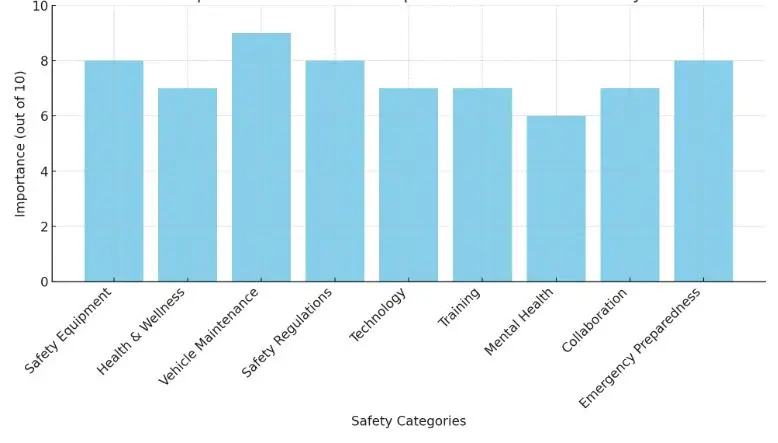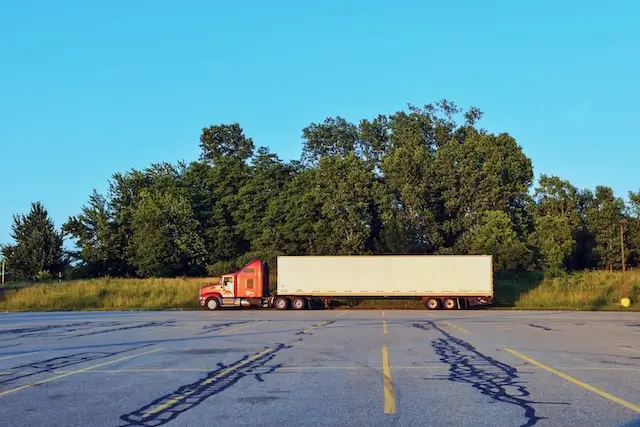
58 Essential Truck Driver Safety Topics: Navigating the Road with Care
| Key Point | Details |
|---|---|
| Safety Equipment | Importance of essential safety tools and accessories for truckers. |
| Health and Wellness | Prioritizing truck driver health for safety on the road. |
| Vehicle Maintenance | The role of regular vehicle maintenance and upgrades in ensuring safety. |
| Safety Regulations | Understanding and adhering to trucking industry safety regulations. |
Truck Driver Safety Topics Guide
Trucking is more than just a profession; it’s a lifestyle that demands both skill and caution. For those behind the wheel of a big rig, knowing and adhering to truck driver safety topics is not just a requirement but a necessity for their own safety and that of others on the road. In this comprehensive guide, we explore the critical aspects of truck driver safety, from essential equipment to health and wellness strategies.
1. Essential Safety Equipment for Truck Driver Safety Topics
Safety starts with having the right tools and accessories. Whether it’s for personal protection or ensuring the truck is well-equipped, having the necessary safety gear is crucial. This includes items like high-visibility vests, safety glasses, and proper footwear to prevent slips and falls. For a more detailed look at what constitutes essential safety gear for truckers, visit our page on Trucker Tools and Accessories, where we dive into the must-have items for every truck driver.
2. Prioritizing Health and Wellness on the Road
Long hours behind the wheel can take a toll on a driver’s physical and mental health. Staying healthy is not just about physical fitness; it’s about managing stress, getting adequate rest, and maintaining a balanced diet. Ignoring these aspects can lead to fatigue and decreased alertness, significantly compromising safety. For tips on maintaining health and wellness while on the road, explore our insights at Tools for Truck Drivers.
3. The Importance of Regular Vehicle Maintenance
Vehicle maintenance is not just about compliance; it’s a critical safety topic. Regular checks and upgrades can prevent breakdowns and accidents caused by vehicle malfunctions. This includes routine inspections, timely repairs, and understanding the latest in vehicle technology and upgrades. For an in-depth discussion on this topic, our Vehicle Maintenance and Upgrades page offers valuable information for truck drivers.
4. Truck Driver Safety Topics Adhering to Safety Regulations
Safety regulations in the trucking industry are not just guidelines; they are lifesaving measures. Understanding and complying with these regulations ensures not only the safety of the truck driver but also that of other road users. This includes knowledge of hours of service regulations, cargo securement rules, and hazardous material handling procedures. For a deeper understanding of these regulations and their impact on trucking operations, visit our About page.
5. Truck Driver Safety Topics Leveraging Technology for Enhanced Safety
In today’s tech-driven world, when discussing truck driver safety topics various technological advancements play a crucial role in enhancing truck driver safety. These include advanced GPS systems for efficient routing, electronic logging devices (ELDs) for hours-of-service compliance, and safety features like lane departure warnings and automatic emergency braking systems. Embracing technology not only aids in adherence to safety regulations but also significantly reduces the chances of accidents and enhances overall road safety.
6. Navigating Hazardous Road Conditions
We know when we consider truck driver safety topics, truck drivers often face challenging road conditions, ranging from severe weather to heavy traffic. Understanding how to navigate these situations safely is paramount. This includes skills like defensive driving, proper cargo securement in changing conditions, and awareness of weather-related driving strategies. Drivers must be prepared to adapt to various scenarios to ensure their safety and the safety of others on the road.
7. Continuous Safety Education and Training
Safety is an ongoing learning process. Regular training and up-to-date knowledge of safety practices and regulations are essential for every truck driver. This involves participating in safety workshops, staying informed about the latest industry updates, and engaging in continuous learning. By doing so, drivers not only enhance their own safety but also contribute to the overall safety culture within the trucking industry.
8. Creating a Culture of Safety
Beyond individual practices, fostering a culture of safety within trucking companies is critical. This involves company policies that prioritize safety, encouraging open communication about safety concerns, and recognizing and rewarding safe driving practices. When safety becomes a core value, it leads to a safer and more responsible trucking industry as a whole.
Truck driver safety encompasses a broad range of topics, from personal safety equipment and health to vehicle maintenance, adherence to regulations, and the embracement of technology. It’s about creating a comprehensive approach that ensures the well-being of the driver and the safety of everyone on the road.

Importance of Different Aspects of Truck Driver Safety
The visualization below represents the importance of different aspects of truck driver safety, rated on a scale of 1 to 10. Categories like ‘Vehicle Maintenance’, ‘Safety Regulations’, and ‘Emergency Preparedness’ score high, emphasizing their critical role in ensuring safety. Other areas like ‘Health & Wellness’, ‘Technology’, and ‘Training’ also play significant roles. This graph underscores the multifaceted nature of safety in the trucking industry, highlighting areas that require attention for overall safety enhancement.

Comprehensive Guide on Truck Driver Safety Topics: Road Safety for Truck and Bus Drivers
In this extensive guide on truck driver safety topics, we draw from the Federal Motor Carrier Safety Administration (FMCSA) to significantly enhance road safety for truck and bus drivers. The complete and detailed guidelines are available at FMCSA’s Tips for Truck and Bus Drivers, offering a rich resource on the unique challenges faced by operators of large vehicles.
9. Truck Driver Safety Topics: Vigilant Blind Spot Monitoring
Among essential truck driver safety topics is the regular checking of mirrors every 8-10 seconds to stay aware of vehicles in your blind spots. Looking ahead for about 15 seconds helps anticipate traffic, work zones, and potential hazards. Further insights are provided in this video.
10. Understanding Stopping Distances for Truck Driver Safety
A crucial aspect of truck driver safety topics includes understanding the lengthy stopping distances required by large vehicles. Adjust your driving speed, particularly in adverse weather or on curvy roads, as explained in this video.
11. Executing Wide Turns: A Key Truck Driver Safety Topic
Wide turns necessitate extra space and time, a significant point in truck driver safety topics. Signal clearly and turn cautiously, as shown in this instructional video.
12. Emphasizing Seat Belt Use in Truck Driver Safety
Adhering to consistent seat belt usage is a lifesaving measure under truck driver safety topics. Discover more about the importance of seat belts for reducing injury risks here.
13. Safe Speed Management: Essential in Truck Driver Safety Topics
Maintaining safe speeds, considering the unique dynamics of large vehicles, is a critical element in truck driver safety topics. Adjust your speed to suit varying road conditions and inclines.
14. Focused, Distraction-Free Driving: A Core Truck Driver Safety Topic
Ensure adequate rest, avoid drowsy-inducing medications, and eliminate distractions like texting – essential practices in truck driver safety topics. Pull over safely if you need to address other activities.
15. Effective Signaling: A Fundamental Truck Driver Safety Topic
Early signaling of your driving intentions and using emergency signals when necessary are key practices under truck driver safety topics.
16. Diligent Vehicle Maintenance: A Pillar of Truck Driver Safety
Conducting regular pre-trip inspections, especially focusing on tires and brakes, is vital for truck driver safety. Secure cargo balance is crucial to prevent control loss.
17. Strategic Trip Planning in Truck Driver Safety
Being informed about weather and road conditions is a significant aspect of truck driver safety topics, ensuring a well-planned and safe journey.
18. Work Zone Protocols: Integral to Truck Driver Safety Topics
Exercising extra caution in work zones is a critical part of truck driver safety. Slow down, maintain space, and stay alert to changing traffic patterns and road workers.
Adopting these truck driver safety topics, adapted from FMCSA guidelines, equips truck and bus drivers with a comprehensive approach to ensuring road safety, addressing the complexities of operating large vehicles. The FMCSA’s resource is a valuable tool in fostering a safer driving environment within the trucking industry.

Safety Protocols at Truck Stops and Parking Areas
19. Practice G.O.A.L. (Get Out And Look)
Before reversing your truck, it’s crucial to exit the vehicle and survey the surroundings. This practice ensures that you are fully aware of any potential hazards during the backing process.
20. Secure Your Cargo
Trucks left unattended are prime targets for theft. Always ensure your truck is locked securely, especially if you’re stepping away. This simple act significantly reduces the risk of robbery.
21. Vigilant Door Locking at Truck Stops
Not just your cargo, but your truck itself is vulnerable to theft. From money and supplies to electronics, everything inside is at risk. Make it a habit to lock all doors whenever you leave the truck, safeguarding your belongings.
22. Inspect Delivery Locations Personally
Don’t rely solely on the assurances of customers or shippers regarding the suitability of delivery spots. Take the time to physically inspect these areas, verifying that your truck can safely maneuver in and out without causing traffic disruptions.
23. Discerning Choice of Truck Stops
All truck stops are not created equal. Prioritize stops with good lighting and a reasonable number of parked trucks. A deserted or poorly lit truck stop can pose safety risks. When possible, park amidst other trucks for added security.
24. Caution During Freight Unloading
Unloading presents its own set of hazards, from personal injury to cargo damage and theft risks. Approach this task with diligence, ensuring both your safety and the security of the freight.
25. Secure Your Truck During Overnight Stops
The vulnerability of your truck extends to nighttime hours. Ensure all doors are securely locked while sleeping to prevent break-ins and personal assault risks.
26. Discretion About Cargo Details
The less known about your cargo’s value, the safer you are from potential theft. Refrain from discussing the nature of your load in public or over the radio. Thieves are less inclined to target a truck when uncertain of its contents’ value.
Implementing these safety protocols during stops and parking can significantly enhance your security and that of your cargo. Always stay vigilant and proactive in protecting yourself and your truck.

Comprehensive Truck Inspection Guide
27. Inspecting the Engine Compartment
Prior to embarking on any trip, a thorough inspection of your truck is essential. In the engine compartment, ensure all fluids are at optimal levels and inspect belts and wiring insulation for any signs of wear or damage.
28. Tire Maintenance Checks
Given the heavy usage of your tires, conduct meticulous checks for foreign objects like nails that could cause a blowout. Monitor tire pressure and tread depth regularly, and replace tires when necessary to ensure safety.
29. Load Verification
Confirm that your load is securely fastened and double-check that you have the correct cargo. Avoid the costly mistake of transporting the wrong load over long distances.
30. Fluid Level Assessments
Regularly check essential fluid levels including oil, coolant, power steering, brake, and windshield wiper fluids before setting off.
31. Identifying Coolant or Oil Leaks
An easy method to detect leaks is to move your truck a few feet after it has been stationary for several hours. Look for any puddles on the ground, indicating a potential leak.
32. Brake System Inspection
The condition of your brakes is critical for safety. Examine the brake lining thickness, check air lines for damage, and ensure proper brake alignment. Address any signs of wear or damage immediately.
33. Lighting and Reflector Checks
Verify the functionality of all headlights, brake lights, warning lights, and turn signals. This inspection is more effective in darker conditions. Also, inspect reflectors for any damage.
34. Safe Vehicle Exit Procedures
Always prioritize safety when exiting your vehicle. Maintain three points of contact and avoid jumping from the cab. Be cautious of slippery surfaces to prevent falls.
35. Coupling System Inspection
A faulty coupling system poses a significant risk. Thoroughly check the fifth wheel, air lines, gap, mounting bolts, and locking jaws for any signs of damage and ensure they are correctly positioned to avoid trailer detachment.
Adhering to these comprehensive inspection guidelines not only enhances your safety but also ensures the optimal performance of your truck. Regular and thorough inspections are key to a successful and safe journey.

Navigating Weather Challenges on the Road
36. Ensuring Safety in Poor Visibility
With approximately 600 feet needed to stop your vehicle, driving in reduced visibility is highly risky. If you cannot see this distance ahead, it’s safest to not drive at all. In conditions where visibility is compromised, proceed with caution and reduced speed.
37. Handling Intense Heat
High temperatures can cause tire bursts due to the expansion of air inside them. In extreme heat, it’s vital to give your tires regular breaks to avoid this risk, especially during long drives.
38. Dealing with Impassable Snow
In situations where heavy snowfall makes the road impassable, safely park your truck and keep the engine running to prevent fluid freezing. Use flashing lights for visibility and alert emergency services of your location if necessary.
39. Caution with Black Ice
Black ice, nearly invisible on roads, significantly reduces traction, even with tire chains. Drive very slowly in icy conditions and if the road seems overly icy, it’s safer to pull over and wait for road services to clear the ice.
40. Choosing the Right Sunglasses
Invest in high-quality sunglasses for driving in bright conditions. While they may be costlier, they provide superior eye protection and are a long-term investment. Remember to remove them in low light conditions or at night.
41. Nighttime Driving Precautions
Night driving comes with unique challenges, including decreased visibility and nocturnal wildlife. Extra caution is necessary to navigate these additional risks safely.
42. Responding to High Wind Conditions
High winds, particularly on bridges, can lead to dangerous situations like vehicle rollovers. If you feel your truck swaying due to wind, it’s imperative to pull over immediately and wait for conditions to improve.
Adapting to these weather-related driving challenges is crucial for the safety of truck drivers. Being prepared and aware of how to respond in different weather conditions can make a significant difference in ensuring a safe journey.

Essential Safety Tips for Truck Drivers: Comprehensive Guide
For truck drivers, safety is a continuous journey that goes beyond obtaining a Commercial Driver’s License (CDL). Embracing a “safety first and always” mindset is critical at every stage of your driving career. To help reinforce this approach, we’ve compiled 16 vital truck driver safety tips. These guidelines are beneficial for both seasoned and novice drivers, emphasizing the importance of staying safe on the road.
Pre-Trip: 5 Essential Truck Driver Safety Tips
43. Self-Care for Truck Drivers
As the most valuable asset in your truck, prioritize your well-being by:
- Ensuring quality sleep.
- Incorporating exercise and stretching.
- Preparing healthier meals in your truck.
- Investing in comfort-enhancing items like sunshade covers and a seat cushion.
44. Detailed Trip Planning
Before you embark, stay updated on:
- Weather and road conditions.
- Traffic patterns and construction.
- Low bridges and driving regulations.
These are among the many crucial trip planning aspects for truck drivers.
45. Emergency Kit Preparation
Keep a tailored emergency kit in your truck, suited to your driving type, freight, and climate.
- Consider a pre-made kit or customize your own.
46. Comfort in the Cab
Adjust your seating and steering for comfort. Set up your GPS beforehand and plan regular breaks.
47. Three-Point Contact
Always use three points of contact when entering or exiting your truck to avoid slips and falls. Keep hands free for a firm grip.
On the Road: 6 Crucial Truck Driver Safety Tips
48. Safe Lane Changes
Employ the “Take 10” method for lane changes:
- Thoroughly check mirrors and blind spots.
- Signal for at least three seconds.
- Take seven seconds for the lane change, maintaining awareness.
49. Extra Caution in Work and School Zones
Slow down, leave extra space, and stay alert to signs, workers, and uneven roads.
50. Predictable and Slow Driving
Drive predictably by:
- Taking turns slowly.
- Avoiding unnecessary lane changes.
- Using turn signals in advance and maintaining them until the maneuver is complete.
- Keeping headlights on during low-light conditions for visibility.
51. Maintaining Safe Distance
Keep a seven to eight-second distance from the vehicle ahead, extending it in adverse weather conditions.
52. Focus on Driving
Stay alert by:
- Avoiding phone use while driving.
- Turning off the radio in challenging conditions.
- Limiting distractions and practicing good sleeping habits.
53. Situational Awareness
Regularly scan your surroundings and maintain awareness of your vehicle’s blind spots.
Destination: 5 Key Truck Driver Safety Tips
54. Get Out And Look (G.O.A.L.)
Always inspect your parking or docking spot by getting out of the truck to ensure safe maneuvering.
55. Parking Location Inspection
Before parking or coupling, inspect the area for safety and suitability.
56. Safe Handling of Landing Gear
Wear gloves and maintain balance while working with landing gear, avoiding quick movements.
57. Wise Unloading of Freight
Before opening trailer doors, check for potential obstructions and secure the doors after opening.
58. Post-Trip Truck Inspection
Conduct a thorough inspection after your trip, reporting any issues or defects immediately.
Following these truck driver safety topics not only enhances your personal safety but also contributes to the overall safety of the roadways. Remember, being a safe truck driver is a continuous commitment that extends far beyond the initial training and certification.
Truck Driver Safety FAQ
A truck driver should have comprehensive knowledge of traffic laws, regulations, and safety protocols. They should also be skilled in vehicle operation, load securing, and navigation. Additionally, awareness of weather conditions, road hazards, and fatigue management is crucial for safe and efficient driving.
One of the challenges in truck driving is the long hours spent on the road, often leading to time away from home and family. Managing fatigue, dealing with unpredictable weather conditions, and navigating through traffic are also among the difficulties that truck drivers may face.
Many truckers value safety, job security, and fair compensation. They also appreciate support from their employers and the opportunity to maintain a healthy work-life balance. Access to clean facilities, reliable equipment, and effective communication are essential for their well-being.
To drive safely around trucks, maintain a safe following distance, avoid blind spots (such as the “no-zone” areas), and give trucks plenty of space when changing lanes. Be patient and avoid aggressive driving behaviors. Always signal your intentions and be cautious when passing or merging near trucks.
Driving near big trucks can pose risks due to their size and limited visibility. Dangers include being in their blind spots, being at risk of rear-end collisions if following too closely, and the potential for rollovers if a truck takes evasive action. It’s essential to exercise caution when sharing the road with large trucks.
Safe driving involves following speed limits, obeying traffic laws, avoiding distractions (such as texting or phone use), wearing seat belts, maintaining a safe following distance, and staying alert. Regular vehicle maintenance, adherence to hours-of-service regulations, and respecting road conditions are also critical.
Critical aspects of safe driving include staying focused, avoiding impaired or fatigued driving, obeying traffic laws and speed limits, adjusting to weather conditions, and maintaining a well-maintained vehicle. Defensive driving techniques and anticipating the actions of other road users are also vital.
Safe long-distance driving involves planning your route, getting adequate rest before the journey, taking regular breaks to combat fatigue, staying hydrated, and avoiding distractions. Ensure your vehicle is in good condition, and plan for potential emergencies with essential supplies and roadside assistance contact information.
Some effective road safety slogans include “Drive Safely, Arrive Safely,” “Don’t Text and Drive,” “Speed Thrills, But Kills,” “Stay Alert, Stay Alive,” and “Seat Belts Save Lives.” These slogans emphasize the importance of safe driving practices and responsible behavior on the road.
AmeriTrust Our Journey
AmeriTrust began its journey 8 years ago, born from our passion for logistics and transportation. Over the past three decades, we’ve traversed the globe, embracing its wonders. Each day has been an adventure, filled with the joys of discovery. We’ve rested in the lap of luxury and found solace in simplicity, sometimes uncertain about tomorrow’s well-being. We’ve shared laughter, shed tears, and counted our blessings. Now, we aspire to impart the richness of our experiences to you and enhance your road travel. This site and its articles may feature affiliate links and advertisements. Should you choose to make a purchase or engage with the content we recommend, it may support us with a commission or compensation. Rest assured, it comes at no extra cost to you and aids in sustaining this website.

